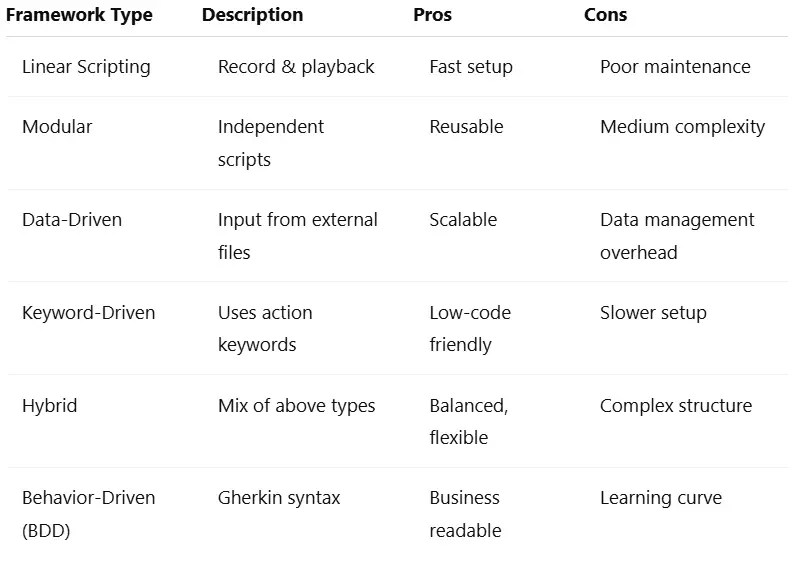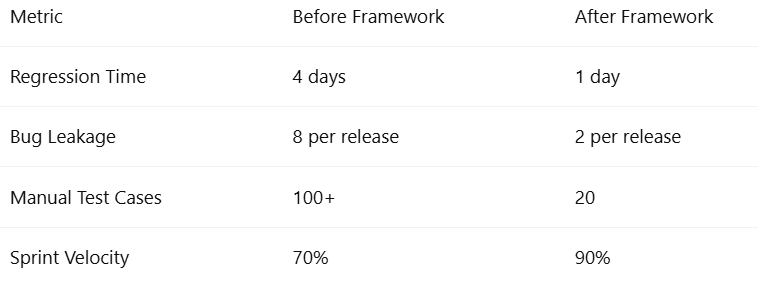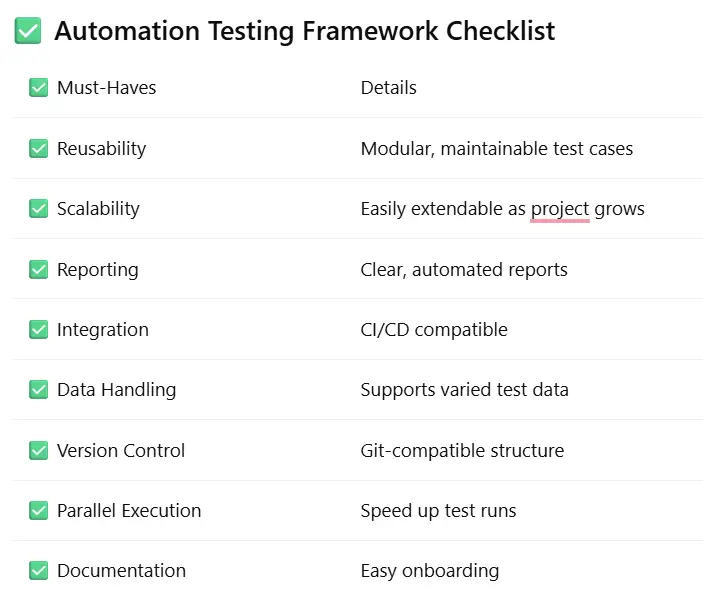 TESTING FRAMEWORK
TESTING FRAMEWORK Automation Testing Framework: A QA Engineer's Complete Guide

Why Automation Testing Frameworks Matter Today
Let me take you back to a project I was once assigned — a high-pressure release cycle for a fintech app where the QA team was stuck in a never-ending loop of manual regression. Every sprint, we wasted dozens of hours clicking through the same flows, missing critical defects in the process. That was the wake-up call I needed. I knew we had to evolve — and fast.
What saved us? A well-designed automation testing framework.
If you've ever found yourself chasing test cases, fixing fragile scripts, or struggling with flaky results, this blog post is for you. I'm going to walk you through everything I've learned — from what an automation framework is, to designing one that scales beautifully and delivers results your team can trust.
Let’s dive into it. 🧪
🔍 What is an Automation Testing Framework?
Think of an automation testing framework as the skeletal structure for your entire automation effort — just like blueprints and steel beams for a skyscraper. Without a solid framework, your scripts become brittle, unorganized, and impossible to maintain.
In my experience, a good framework includes:
- Drivers to connect test scripts with the browser or application
- Test Scripts written using best practices
- Test Data stored externally or generated dynamically
- Logging & Reporting tools for visibility
- Configuration Files to manage environments
- Utilities for reusability and maintenance
It supports all types of testing — from unit to UI to integration — depending on how it's architected.
🔑 Key takeaway: A good automation framework empowers you to scale testing, integrate with CI/CD, and reduce manual regression time significantly.
🧱 Core Components of a Solid Automation Testing Framework
Let’s break down the building blocks that make a framework truly scalable and maintainable.
1. 📜 Test Scripts & Modularization
Modularization is non-negotiable. I rely heavily on design patterns like Page Object Model (POM) to separate UI logic from test logic. This makes the framework much easier to debug and maintain.
2. 🗃️ Test Data Management
I learned the hard way that hardcoding test data is a recipe for disaster. Instead, I now use:
- Excel/CSV files for static data
- JSON or YAML for dynamic configs
- Database calls or mocks for complex data
This helps me easily run multiple scenarios with minimal changes to the code.
3. 📊 Reporting & Logging
Tools like Allure or custom HTML reports help me visualize:
- Passed/failed/skipped tests
- Execution time
- Error logs and screenshots
This visibility is critical, especially during sprint reviews.
4. 🔄 Exception Handling & Recovery
Real-world testing means real-world failures. My framework always captures:
- Screenshots on failure
- Stack traces
- Retry mechanisms for flaky steps
5. 🔗 CI/CD Integration
Automation is useless if it isn't continuous. I integrate my framework with Jenkins, GitHub Actions, or GitLab CI to auto-trigger on code pushes.
🎯 Result: Developers get fast feedback, and bugs are caught early.
🧪 Types of Automation Testing Frameworks (With Pros & Cons)
Here’s a table I keep handy whenever I need to choose or recommend a framework style:

From my personal experience:
- For startups: Modular + Data-Driven is a great balance
- For large-scale systems: Hybrid or BDD is worth the effort
🏗️ How to Design Your Own Automation Testing Framework
1. 🎯 Define Your Objectives
Ask yourself:
- Do we need fast feedback?
- Are we testing across multiple browsers or devices?
- Who will use the framework — engineers only, or testers too?
This sets the tone for everything else.
2. ⚒️ Choose the Right Tools & Language
My golden rule: pick tools that fit your team’s skills. No point in using Cypress if your team is fluent in Java + Selenium.
- Selenium + TestNG for traditional web apps
- Cypress for modern JS-heavy apps
- Appium for mobile
- Playwright for cross-browser testing
3. 📁 Structure the Folder Hierarchy
Here’s the structure I use:
/tests /pages /data /utilities /testcases /config /reports
Simple, clean, and easy to onboard new team members.
4. 🚀 Set Up Version Control & CI/CD
Always version your test code. Integrate with Jenkins or GitHub Actions to:
- Run smoke tests on every PR
- Run regression on nightly builds
- Deploy only if tests pass
5. 🔁 Create a Feedback Loop
Every month, I audit my framework for:
- Redundant tests
- Flaky behaviors
- Time-consuming flows
This ensures continuous improvement.
⚙️ Best Practices for Automation Testing Frameworks
Here’s what I live by:
✅ Keep tests atomic (independent and focused)
✅ Use clear naming conventions for files and methods
✅ Externalize test data — NEVER hardcode
✅ Group tests using tags for selective runs
✅ Write robust assertions, not just presence checks
✅ Run parallel tests with tools like TestNG or PyTest
✅ Maintain documentation — README, contribution guide, etc.
✅ Regularly review test failures and update accordingly
These best practices helped me reduce test maintenance time by 40% over two quarters.
💡 Common Mistakes to Avoid in Automation Frameworks
Avoid these if you want to keep your sanity:
❌ Overengineering: Don’t build a rocket for a paper airplane
❌ Ignoring test data: Leads to brittle tests
❌ No logging/reporting: Makes failures hard to diagnose
❌ Poor script organization: Leads to duplication and confusion
❌ Lack of environment config: Makes portability impossible
In one project, skipping proper data management led to 120 flaky tests — took us two full sprints to refactor. Lesson learned.
🔄 Real-World Example: Building a Hybrid Automation Framework
A few years ago, I built a hybrid framework using:
- Selenium for browser automation
- TestNG for test execution
- Maven for dependency management
- Jenkins for CI/CD
- ExtentReports for beautiful reporting
We created:
- Page Objects for each screen
- JSON files for test data
- Reusable utility functions
The result?
- 80% test coverage
- 50% faster regression cycles
- Zero critical defects in production for 3 straight sprints
📈 Measuring the ROI of an Automation Testing Framework
Automation isn’t just a checkbox — it should provide measurable value.
I track:
- 🔁 Test execution time
- 🐞 Defect leakage post-release
- 📉 Manual effort reduction
- ⏱️ Time saved per sprint
Here’s a sample before/after from one of my teams:

🛠️ Tools That Support Automation Testing Frameworks
These are my go-to tools based on the type of application:
- Selenium – Web automation
- Cypress – Modern web apps
- Playwright – Cross-browser modern automation
- TestNG/JUnit – Test management
- Appium – Mobile automation
- Postman/Newman – API testing
- Allure/ExtentReports – Reporting
- Jenkins/GitHub Actions – CI/CD pipelines
Pick tools based on:
- Team expertise
- Application tech stack
- Integration needs
Automation Testing Framework Checklist

❓ FAQ Section: Automation Testing Framework
❓ What is the purpose of an automation testing framework?
An automation testing framework provides structure to your automation efforts, making them maintainable, scalable, and effective across sprints and teams.
❓ Which type of automation testing framework is best?
There’s no one-size-fits-all. I recommend hybrid or data-driven frameworks for most real-world projects, depending on your goals and complexity.
❓ Can I build an automation framework from scratch?
Absolutely. I’ve built multiple from scratch. Start small, validate, iterate, and grow based on feedback and failures.
❓ Is Selenium a framework or a tool?
Selenium is a tool. You use it as part of a larger framework that includes data handling, logging, test management, and reporting.
❓ What are the key benefits of using an automation testing framework?
Key benefits include:
- 📈 Faster release cycles
- 🛠️ Easier script maintenance
- 🔗 CI/CD compatibility
- 📊 Better visibility through reporting
- 💰 Long-term cost efficiency
❓ How does a framework support CI/CD in testing?
A good framework integrates seamlessly with CI/CD tools, ensuring that your tests run automatically with every code push or merge, giving instant feedback to developers.
Build Smarter, Not Harder
If there’s one thing I’ve learned in my QA journey, it’s that a good framework is not about tools or trends — it’s about reliability, scalability, and maintainability. We compiled a few interview questions on the Automation Testing Framework, which will help in your job interview.
The right automation testing framework can make the difference between barely surviving sprint reviews and leading your team into confident, clean releases.
So take a step back. Audit what you have. Talk to your team. And start laying the foundation for a framework that not only works — but thrives.
Happy testing! 🚀
